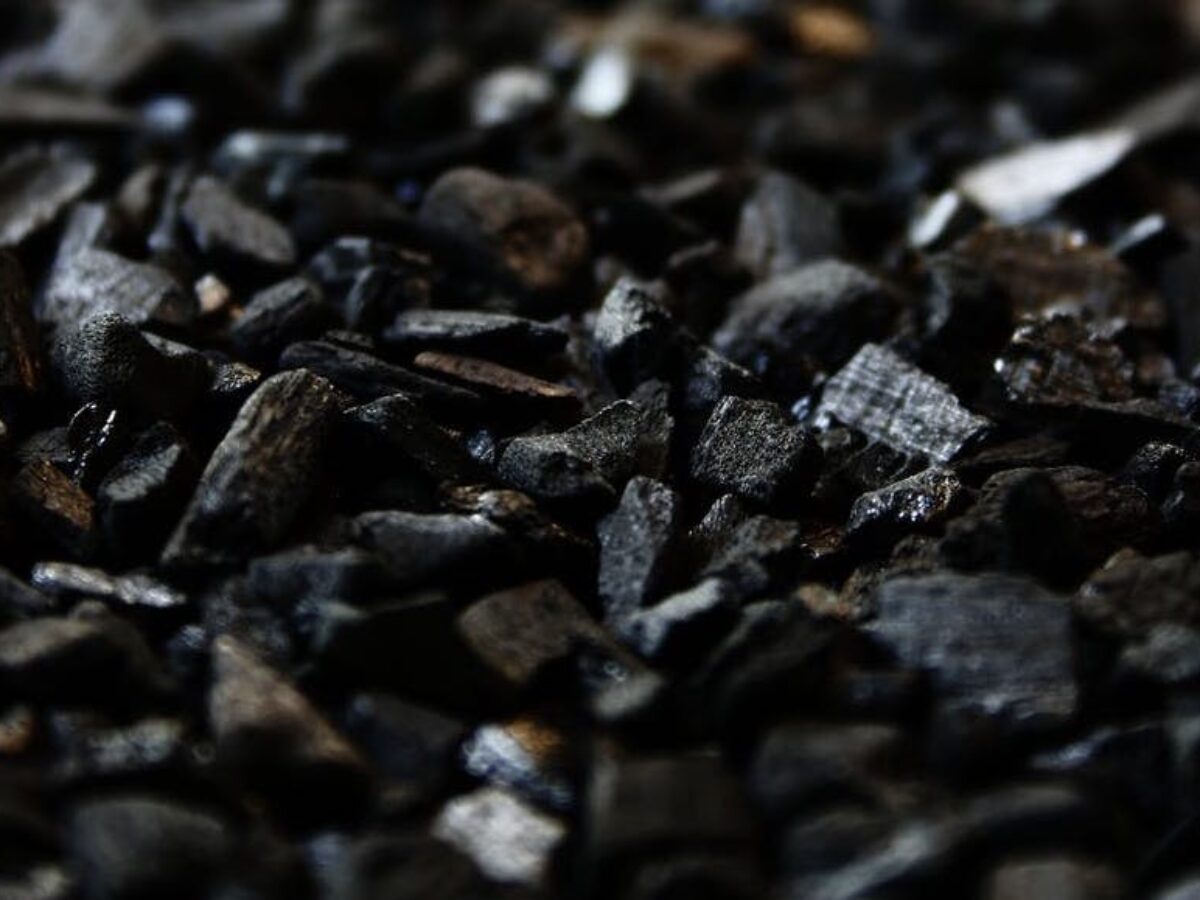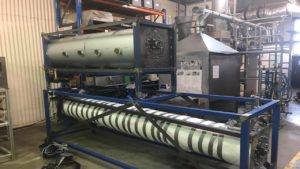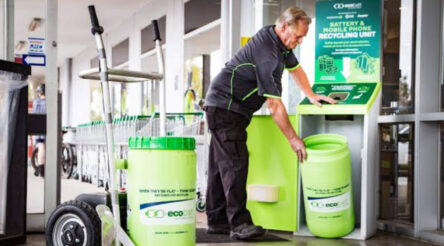In the black: startup pushing ahead commercialising waste-to-activated-carbon technology

Environmental technology company Bygen is taking technology out of University of Adelaide labs and using it to give agricultural waste a higher purpose. Brent Balinski spoke to co-founder and CEO Dr Lewis Dunnigan about using almond shells and other ingredients to supply the growing activated carbon market.
It is hard to find a business with plans unaffected by the unfolding COVID-19 crisis. Startup technology companies, which face a generally complicated life, are seeing things become more complicated still.
But the show, as they say, must go on.
This is the case for Bygen, a University of Adelaide spin-out that recently went through the Startmate accelerator’s climate cohort. (It is the case for Startmate, too, which is preparing to host its demo day by live stream next month.)
Bygen is commercialising chemical engineering work spun out of the University of Adelaide. This promises a process for low-cost activated carbon out of agricultural waste, following pyrolysis.
According to one market research firm, the global market for activated carbon was $US 4.7 billion in 2015, and will grow 9.4 per cent annually to reach $US 8.1 billion in 2021, or 5,400 kilotons by volume. It is widely used in filtration in the food and beverage industry, in metal extraction, sewage treatment, cleaning up industrial gas produced and many other applications. Prices are roughly $2,000 a tonne currently.
Bygen believes there’s a niche in there for a “bespoke” product, and are targeting an unmet demand for purpose-specific products, where their process allows for the control of pore size.
Bygen has completed an initial $300,000 seed funding round, and is in the middle of a $600,000 second seed round to fund a first full-scale plant. Further, in November last year they announced they had seen early success adapting their process to plastics, turning these into activated carbon and possibly one much-needed answer to Australia’s acknowledged plastics crisis. It is seeking industrial partners to take this work further.
Late last week @AuManufacturing spoke to CEO Dr Lewis Dunnigan, who founded the company in 2018 with CTO Ben Morton and chemistry senior lecturer Dr Philip Kwong.
@AuManufacturing: What’s the business’s origin story?

Lewis Dunnigan: I’m originally from Scotland. I did my chemical engineering degree at the University of Edinburgh. And I came over to Adelaide for six months during my master’s degree. Essentially after I finished my master’s degree I was offered a scholarship to come do a PhD at the university of Adelaide. So I did that. Six months before I finished my PhD, we actually started the company. As soon as I finished my PhD, I went straight into full-time work. Which was good. We managed to raise some money in between starting the company and me becoming a full time staff member. I’ve been in Australia ever since.
@AuManufacturing: What’s the secret sauce that allows you to turn ag waste, and more recently, plastic into activated carbon?
Lewis Dunnigan: Our technology allows us to avoid the hugely energy-intensive nature of conventional means to make activated carbons. So there’s two main ways to do it, currently. You either do something called physical activation, which requires temperatures around 1000 degrees, or you have another option which is called chemical activation and involves the use of really strong acids or bases. Both have their negatives. And what we are focused on is the physical activation. What we’ve developed is an alternative to those extremely high-temperature methods of making activated carbon. Our methods can operate at much lower temperatures. We can use cheaper gas mixtures. Our reaction times are quicker and also because of our lower temperatures we also have a reduction in the capital costs as well, because we don’t need to use the same types of steel that conventional producers need to use.
@AuManufacturing: Roughly speaking, is the Bygen process building on your PhD work or related to it?
Lewis Dunnigan: Basically myself and my co-founder, Ben Morton, we were both PhD students in the same group at Adelaide Uni. And we basically felt like we had two complimentary research projects that we were doing. And if we combine them together we had quite a promising technology for the activated carbon market, which we knew at the time was a large market and the technology has potential commercial implications.
So basically the way the company was founded was while Ben and I were talking about starting a company, independently of that our supervisor actually got us into a waste and recycling accelerator run by Innovyz down at Tonsley and we basically just took off from there.
@AuManufacturing: Tell us about inputs and outputs. I read that you’re producing activated carbon from agricultural waste at about 10 kilograms per hour. You might have scaled up since that article. What goes in and what comes out?
Lewis Dunnigan: The first pilot plant we built, like you said, can produce 10 kilograms an hour. We are just finishing off a new machine that can do about four times that, about 40 kilograms an hour. Our ultimate intention is to produce about 500 kilograms an hour or more. The first plant was very much about proving the technology could work. This one is about getting to that first level of commercialisation.
Essentially for every tonne you put in of weight agricultural waste, you get about 200 to 250 kilograms an hour out. So it’s about 20 to 25 per cent yield.
@AuManufacturing: And the rest escapes as gas slash heat?
Lewis Dunnigan: Yes, correct. We produce quite a lot of heat as a byproduct. The rest comes out and is turned into a gas that we can burn and we can re-circulate that gas internally for heating.
@AuManufacturing: How have you found the transition from engineer and scientist to entrepreneur? Has it been enjoyable or a headache? Do you miss the lab at all?
Lewis Dunnigan: I’ve enjoyed it a lot and Ben has enjoyed it a lot. We have had to learn very, very quickly. But I think that the skills you learn when you’re doing a PhD [are useful] in terms of having to be inquisitive about things, having to be really strict in how you use your time and your resources to achieve what you want to achieve. I think that mindset has helped us.
The other stuff that comes with running a company in terms of talking to customers, strategy, marketing, and all those other things we’ve had to learn really quickly. And our policy has always been that we need to surround ourselves with people with experience and skillsets that we don’t have.
@AuManufacturing: Is grape marc a focus as an ag waste feedstock? You’ve got plenty of it around Adelaide and it’s a waste stream in need of higher-value purposes.
Lewis Dunnigan: That’s one of them for sure. We also deal a lot with nutshells, specifically almond shells in the Riverland, as well as with people who produce large quantities of waste wood as well. Each feedstock stock makes a product that has slightly different properties, and therefore is suitable for different activated carbon markets. It really comes down to, what’s our first target, and which feedstock should we use for that first market segment that we’re trying to get into.
@AuManufacturing: I see. I saw more recently that you started looking at plastics. Was there a Eureka moment? How does your process lend itself to processing various types of plastics?
Lewis Dunnigan: This was kind of around the time there were a lot of issues coming up with Australia’s ability to handle its own recycling, around the time when some countries stopped taking waste from us. And we felt like there was an abundance of plastics without the processing capabilities internally to deal with all that waste. We felt like theoretically we should be able to achieve a good quality activated carbon with some of the plastics that are available. We literally took some waste PET and applied some pre-processing to it, ran it through our process. Obviously there was a bit of optimisation involved in that. There were a few trials. But we managed to prove we could make high-quality activated carbon from it. We produce a lot of heat at the same time, so the plastics [application is] has the potential to have co-generation of activated carbon and electricity. And the good thing about our process is it’s durable enough to actually take mixed plastics as well. Although there’s different qualities of activated carbon from different types of plastics, PET being the best that we found, it can certainly handle mixtures as well.
@AuManufacturing: That’s very handy, as sorting is a massive headache for plastics recycling, and a stray plastic bag in the mix can be a major issue.
Lewis Dunnigan: Yes, absolutely.
@AuManufacturing: What about the mass processed versus activated carbon coming out? Is it a similar sort of situation to wood waste or almond shells?
Lewis Dunnigan: It varies widely across different plastics. For some plastics you can have much more heat and less carbon coming out. Some are — okay, PET for example is comparable yield-wise to the agricultural waste that we use. But some plastics give much lower yields of solids than PET does. At the same time there’s some plastics that get slightly higher yields than PET. It varies widely and compared to agricultural waste. Generally they’re quite similar, but there’s a much wider range.
Our current attitude with the plastics is we’re very much on the lookout for a partner who can bring the resources to actually commercialise this successfully. Our top priority right now is agricultural, because we’ve built up a lot of market knowledge around product quality, whereas with the plastics we have less experience with that. So it’s very much a case of we want to find the right partner to work with us and then use the technology to, to actually get into the markets.
@AuManufacturing: How is the second seed funding round progressing? Obviously there are some complications out there right now.
Lewis Dunnigan: Obviously we are trying to keep on top of the current situation. At the moment it seems to be okay. We’re not raising any red red flags right now. Like for most companies, most startups, it’s a pretty tricky time. We are considering raising a bit more money than we initially planned to give us that security, longer term. But that’s just a discussion that we are having with investors right now. But touch wood, it seems to be going quite well right now.
On the technical side there are two things that maybe I could mention please. When I was talking about the technology that we developed, in terms of lower energy, lower cost, um, there’s a couple of other things I just wanted to add.

The company’s reactor.
The first one is what we’ve found from doing analysis of the activated carbon on the market as well as market research and talking to customers — one of the problems that we found is that the activated carbon that’s available is almost like a one-size-fits-all approach. There’s little variation between products, despite their very wide range of applications that activated carbon is used in. What often happens is that customers have to buy different types of carbon, blend it together, do their own in-house R&D and figure out what the right ratio of different products is. That’s not great. What we’ve moved towards quite lately with our technology is becoming what we term a bespoke activated carbon producer. If you look at environmental remediation, which is probably the area we focus most heavily on, the pollutants that are out there vary widely in terms of their size, their chemistry, their structure. And we can design carbons that are tailored for these differences.
Usually what people look at is the surface area. There’s sort of the attitude that if you have a higher surface area, then that is better. And that’s not necessarily always the case.
For PFAS, the firefighting foam, activated carbon is used for that. For remediating it from soil and water. PFAS is actually a very large chemical. It’s a family of chemicals. But they’re generally quite large. And with the activated carbon that’s out there, most of the pores – which are the small holes that give the surface area to the carbon – are actually not suited to PFAS in terms of their size and the structure. What we are doing right now is developing something that takes those unique properties of PFS into account, and this is something that we’re really excited about. Because that same model can be used for essentially any pollutant or any kind of water treatment process, and that’s something that I think we’re very interested in. And we’ve kind of made it our mission now to become the bespoke activated carbon producer in the world.
And the other thing is, and which is why we got into [accelerator program] Startmate, is by using agricultural waste, our process is actually carbon negative, and that actually results in a net reduction of carbon.
The ag waste would become methane, a really bad green greenhouse gas, as it decomposes.
Absolutely. So either the agricultural waste would decompose into methane and CO2. We stop them from doing that. The other advantage is that the majority of the world’s activated carbon is made from coal. So that is certainly not a carbon negative process. It’s about us finding a sustainable and climate-friendly alternative to coal-based activated carbon. To us, that sustainability, low-cost and tailoring approach is what we sell as our unique unique point.
This interview has been lightly edited for clarity.
Subscribe to our free @AuManufacturing newsletter here.
@aumanufacturing Sections
Analysis and Commentary Awards Defence Manufacturing News Podcast Technology Videos










